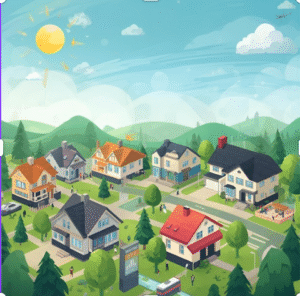Real Estate Rise of Remote Work and Its Impact
Remote work has shifted housing preferences significantly, with many people opting for locations that prioritize lifestyle over proximity to their workplace. This adjustment has opened opportunities for Real Estate markets in smaller cities, rural areas, and regions offering more affordable housing. Buyers are exploring options that provide larger spaces, outdoor areas, and access to nature, as these features are increasingly valued by remote workers seeking a better work-life balance.
As people spend more time at home, the importance of functionality within living spaces has grown. Open floor plans, natural light, and layouts that allow for separation between work and personal life have become essential considerations. Many buyers are prioritizing homes with features that cater to remote work needs, such as additional bedrooms, lofts, or finished basements that can easily transform into private workspaces.

Beyond physical space, location preferences have shifted in favor of areas with strong internet infrastructure and community amenities. Reliable high-speed internet has become a necessity for remote workers, making it a non-negotiable factor in home searches. Additionally, neighborhoods with parks, walking paths, and recreational facilities have gained popularity, as they enhance overall quality of life for those who spend extended periods at home.
This change has also influenced the rental market, with landlords updating properties to meet the needs of remote tenants. Some property owners are incorporating upgrades like soundproofing, built-in desks, and even shared coworking spaces within apartment complexes. These changes cater to a growing segment of renters who require work-friendly environments but are not ready to commit to homeownership.
In many regions, the move toward remote work has reshaped the value of properties once considered less desirable due to their distance from urban centers. Areas with previously stagnant Real Estate markets are now seeing a surge in activity, as remote workers trade the conveniences of city life for the affordability and tranquility of smaller communities. This redistribution of demand has led to significant variations in property prices across different markets, reflecting the evolving priorities of today’s buyers and renters.
Sustainable and Smart Homes
As awareness of environmental issues grows, many homebuyers and renters are actively looking for properties designed with sustainability in mind. Features like energy-efficient windows, advanced HVAC systems, and water-saving fixtures are increasingly common in both new builds and renovations. These upgrades not only reduce resource consumption but also lower utility costs, making them practical and appealing options for those seeking to live more responsibly.
Green building materials are also becoming a top priority, with options such as recycled wood, low-VOC paints, and sustainable flooring gaining traction. These materials not only contribute to healthier indoor air quality but also align with the values of buyers who prioritize eco-friendly living. Developers and homeowners are also investing in landscaping that incorporates native plants and drought-resistant designs, further minimizing water use and maintenance requirements.

Technology has transformed how homes operate, with smart features becoming a key selling point in the Real Estate market. Voice-controlled devices, smart thermostats, and app-based security systems are now seen as essential by many buyers. These systems allow residents to monitor and manage their homes from anywhere, offering convenience and peace of mind. For example, automated lighting systems not only improve energy efficiency but also enhance safety by giving the appearance of occupancy even when homeowners are away.
In addition, buyers are showing growing interest in renewable energy options. Solar panels, in particular, have seen widespread adoption, with many homeowners taking advantage of tax incentives and rebates to offset installation costs. Solar energy systems, combined with battery storage solutions, enable homeowners to reduce dependence on traditional power grids while also contributing to long-term energy savings.
Heating and cooling innovations are another area where sustainability meets modern convenience. Geothermal systems, for example, offer an efficient way to regulate indoor temperatures while significantly reducing energy consumption. These systems, though initially more expensive, appeal to environmentally conscious buyers seeking to lower their carbon footprint.
Homes equipped with energy monitoring tools are also attracting attention. These tools help residents track real-time energy usage, identify inefficiencies, and make informed decisions to reduce overall consumption. For renters, property managers and landlords are integrating smart technologies into rental units to stay competitive, offering features like programmable thermostats, leak detection systems, and package delivery lockers.
The emphasis on sustainability extends beyond individual homes to entire communities. Some neighborhoods are being designed with shared resources such as electric vehicle charging stations, community solar programs, and carpooling initiatives. These features not only support greener lifestyles but also foster a sense of collective responsibility among residents.
Smart and sustainable homes represent the merging of modern technology with eco-conscious design, providing options that meet the evolving expectations of today’s buyers and renters.
The Role of Interest Rates
Interest rates are a significant factor in shaping the Real Estate market, influencing both buyers and sellers. When rates are lower, borrowing becomes more accessible, often resulting in increased demand for properties. This heightened activity can lead to more competitive bidding, potentially driving up property prices in certain areas. On the other hand, when rates rise, buyers may reconsider their budgets or delay their purchases, creating a ripple effect throughout the market.

For those exploring financing options, interest rates play a major role in determining how much homebuyers can afford. Lower rates mean lower monthly payments, which can allow buyers to qualify for higher loan amounts or free up funds for other expenses such as renovations or furnishings. In contrast, even modest increases in rates can affect the total loan amount that buyers qualify for, prompting many to adjust their expectations or search for more affordable properties.
Sellers are also impacted by fluctuations in rates. In a low-rate environment, more buyers may enter the market, potentially leading to faster sales and higher selling prices. However, rising rates could narrow the pool of eligible buyers, making it more challenging for sellers to secure offers at their desired price points. This dynamic can lead to longer times on the market or the need for price adjustments.
Investors in Real Estate are equally sensitive to changes in interest rates. Whether purchasing rental properties or looking to flip homes, the cost of financing can significantly affect profit margins. Rising rates may prompt investors to focus on cash-flow-positive properties or explore alternative financing methods to mitigate higher borrowing costs.
Additionally, the movement of interest rates can impact refinancing activity. When rates are lower, homeowners may look to refinance their existing mortgages to lock in better terms or lower their monthly payments. This trend can also lead to increased home equity borrowing, which some homeowners use for renovations or to consolidate other debts. However, when rates climb, refinancing activity tends to decline, as fewer homeowners find it financially advantageous.
Mortgage lenders also adjust their offerings in response to interest rate changes. When rates are high, lenders may promote adjustable-rate mortgages or other innovative products to attract borrowers. These alternatives often come with lower initial payments, though they may carry risks if rates continue to rise in the future.
The overall Real Estate market can experience shifts in buyer and seller behavior as interest rates fluctuate. These changes often create both challenges and opportunities, with different market segments responding uniquely to rate adjustments.
Shift Towards Multi-Use Properties
As lifestyles evolve, the demand for adaptable living spaces has grown, leading to an increased focus on multi-use properties. These homes are designed to serve diverse purposes, allowing residents to tailor spaces to their specific needs. For example, an extra bedroom may double as a guest room and home office, or a finished basement could be converted into a rental unit or workout area. This flexibility makes multi-use properties particularly appealing to those seeking to maximize functionality without compromising on comfort.

In addition to individual homeowners, developers and property managers are increasingly incorporating versatile designs into new construction projects. Open floor plans that can be easily reconfigured, modular furniture, and sliding walls are becoming more common, enabling spaces to adapt as circumstances change. This design approach supports the growing interest in homes that cater to multiple priorities, such as accommodating remote work, family activities, and even income-generating opportunities like short-term rentals.
The rise of shared living and working arrangements has also influenced the demand for multi-use properties. As more people explore co-living options to reduce expenses and foster connections, properties that can support these setups are becoming highly sought after. These homes often include communal kitchens, shared workspaces, and private bedrooms, creating an environment where residents can balance personal and social needs.
Investors have taken note of the trend, recognizing the value of properties that appeal to a wider range of buyers and renters. Multi-use homes often attract higher demand due to their practicality, making them a sound option for those looking to diversify their Real Estate portfolios. Landlords are also adapting to this shift by offering rental units with flexible layouts or bonus spaces, catering to tenants who value versatility.
Technological advancements have further enhanced the appeal of multi-use properties. Smart home systems allow residents to seamlessly transition spaces between functions, such as adjusting lighting and temperature to create a productive office environment during the day and a cozy living room in the evening. These innovations add a layer of convenience, making it easier for homeowners and renters to adapt their living spaces to meet changing needs.
Communities with properties that encourage multi-functionality are also becoming more prevalent, as they reflect broader changes in how people live and work. Developers are designing neighborhoods with mixed-use buildings that integrate residential, commercial, and recreational spaces. This creates a dynamic living environment where residents can access amenities without the need for extended commutes.
Overall, the growing interest in multi-use properties underscores a broader shift in housing preferences, driven by the desire for homes that can adapt to modern, multifaceted lifestyles. This trend highlights the increasing importance of flexibility and functionality in the Real Estate market, offering opportunities for both buyers and investors alike.
Urban vs. Suburban Dynamics
Urban and suburban Real Estate markets continue to evolve as buyer and renter preferences shift. Urban areas often offer conveniences like walkability, cultural attractions, and diverse dining and entertainment options, making them attractive to those seeking a vibrant lifestyle. However, these benefits often come with higher property prices, smaller living spaces, and elevated costs of living. Suburban areas, on the other hand, appeal to those who prioritize affordability, larger homes, and access to outdoor spaces. These contrasting characteristics shape the choices people make when deciding where to live.
The growing preference for suburban living has also been influenced by changing family dynamics and lifestyle needs. Suburbs frequently offer features like larger yards, family-oriented neighborhoods, and reputable school districts, which attract households with children. Additionally, suburban communities often provide a quieter environment, which many find appealing when compared to the hustle and bustle of urban centers.
Urban markets, however, still hold significant appeal for younger professionals and individuals who value convenience and the unique opportunities that cities offer. Access to public transportation, proximity to workplaces, and a variety of entertainment and cultural events continue to draw residents to city living. In some cases, urban areas are adapting to increased demand for flexibility, with developers creating mixed-use buildings that combine residential, commercial, and recreational spaces to offer a more well-rounded living experience.

While suburban migration has been notable, urban markets are also responding by offering innovative housing solutions. For example, micro-apartments and co-living spaces have gained traction as more affordable options for city residents. These developments cater to those who want to stay in urban environments while managing costs and maximizing convenience.
As these shifts occur, Real Estate investors and developers are tailoring their strategies to align with the demands of both markets. In urban areas, there is a focus on creating spaces that balance affordability with accessibility, while suburban developments often emphasize community features like parks, walking trails, and local shopping hubs.
Ultimately, the interplay between urban and suburban markets reflects the diverse priorities of today’s homebuyers and renters. By understanding these dynamics, individuals can better navigate the Real Estate market and find spaces that align with their unique needs and preferences. see more


